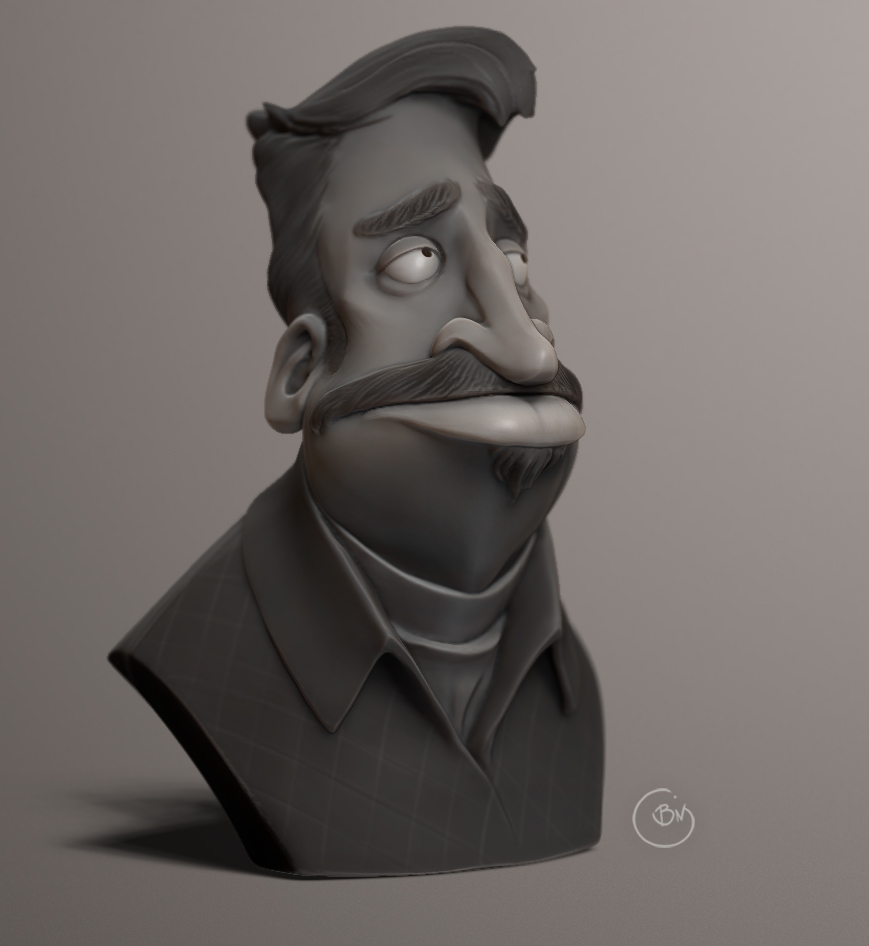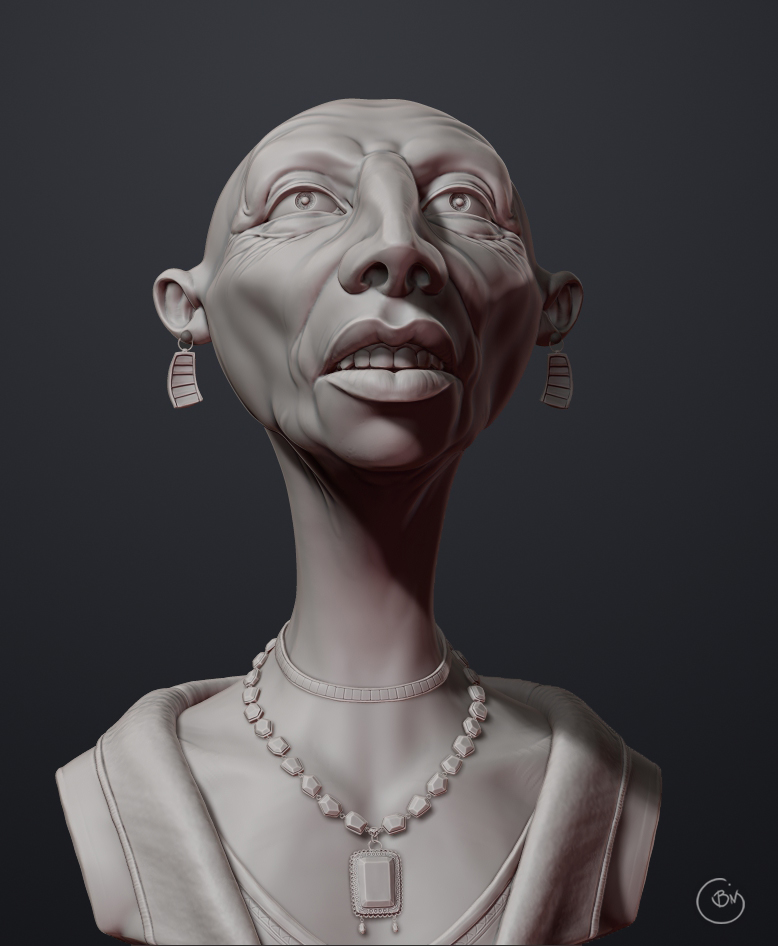For some reason, I refused to post my last few projects because they weren’t as done as I wanted them. I’ve since changed my mind and realized the folly of my ways. Here are the presentable things I’ve been working on and my reasons for making them.
First, here is a fairly quick sculpt (by my standards unfortunately) of a character that I happened to be looking at around the time when I had a sudden urge to work from someone else’s concepts art.
This is based on Mike Clarida’s concept sketch, posted to his coroflot portfolio.
*The difficult part: Adapting those sharp edged cheekbones to three dimensions. Each side was different and I wanted a neutral character, not a pose. I went with significantly reduced cheekbones.
*The easy part: It was incredibly easy to draw out the proportions. There are some basic things I missed, but with stylized characters you can pull in ten different directions and get a unique character each time.


Next, this is a character bust I sculpted from scratch. The only thing I had in mind when I started was a big, long nose. The whole upward looking face thing softened the expression I was going for and the earrings were what defined the character to me. I really wanted to add hair but I couldn’t think straight and ran out of time (ie. I did some of that sleep stuff).
*The difficult part: I approached the necklace wrong and it ends up clashing too much for my tastes. I created four or five random blocky shapes, gave them each bases, and manually spaced them out and connected them. In zbrush. This is something you should do either in maya or with a more interesting workflow in zbrush, something involving randomly chosen chain links on an insert mesh brush or on a micro mesh (if that’s possible) would be ideal.
*The easy part: Facial details are getting a bit easier. I didn’t necessarily think through all the wrinkles and folds, but I seem to be better at placing them in ways that seem, at a glance, to be reasonable.

I have this obsession with understanding an abstract factor that passes through my mind when I see certain sculptures. I call it “bigness”. When I sculpt, I often have a mental block that prevents me from seeing an object as “massive” in the sense that I could zoom in and perfect the volumes on many many levels. The sensation is particularly acute when I encounter extremely fluidly sculpted anatomy or anything else that seems so natural and appropriate that my eyes will double take. It’s like an inverted uncanny valley.
Anyway, I realized that this feeling comes from properly balanced weights and naturally defined volumes. I set out to make a character with good balance and more presence than I usually create. I referred to the save file as a “dumpling” because I intended to make a series of similarly shaped creatures.
*The difficult part: I actually design the character second and the body or face first. It makes things both easy and hard. It’s easy because I can put a hat on it and suddenly it has a personality. It’s hard because I’m starting from one giant puzzle piece and trying to fit it into a mosaic. I added the horns and beard because they were quick and easy and seemed to fit the strange anatomy.
*The easy part: I’ve gotten better at creating a certain unfinished look to my strokes that temporarily puts my perfectionism on hold. Seeing smooth surfaces always makes me thing of maya’s smooth preview. Seeing intentional, directional strokes across forms instead shows me the thought that went into that for. Chaotic strokes and smooth surfaces, at this stage, only indicate that I didn’t understand that part well enough.
*The part that needs more work part: The lack of pose is the biggest downside. It’s hard to notice any quality to the flowing fat rolls when they’re symmetrical like they are. I did some goofiness with the legs too, designing them more like an animal’s hind legs with little to no lower legs at first. I had to modify it to include more human anatomy and did some major changes to the feet to make them match the structure more. I wanted to smooth out and cover those muscles a bit but I need them to be apparent before I pose it so I can understand the pose easier.
I drew some sketches of where to take my “dumpling”. The simplest way to describe it is to say that he’ll have a large leather pouch filled with seeds at his hip, spilling over and growing as they reach the ground. He’s reaching in for a big handful of them and several of them are clearly stuck in his beard and around his cheeks. Passive earthy type.
Finally, here is a quick nose anatomy study. The nose was from an anatomy book I have sitting on my desk (by Valerie Winslow). I didn’t take the time to render it nicely but it worked nicely.
*The difficult part: Sculpting just a fragment of a skull without having the whole thing made for reference. Definitely start from a basic proportional sculpt next time.
I spent a few days trying to make a zscript to automate quick sketch sessions (to set up a few fifteen minute sketches in a row, for example). I figure if a robot tells me what to do, I might actually do it for once. I got 90% of the way to a basic functioning code and then ran into a fundamental limitation in the coding language (apparently). I’ll have to rewrite it to remove the automation. Later, of course.









 small_orange_diamond
small_orange_diamond








